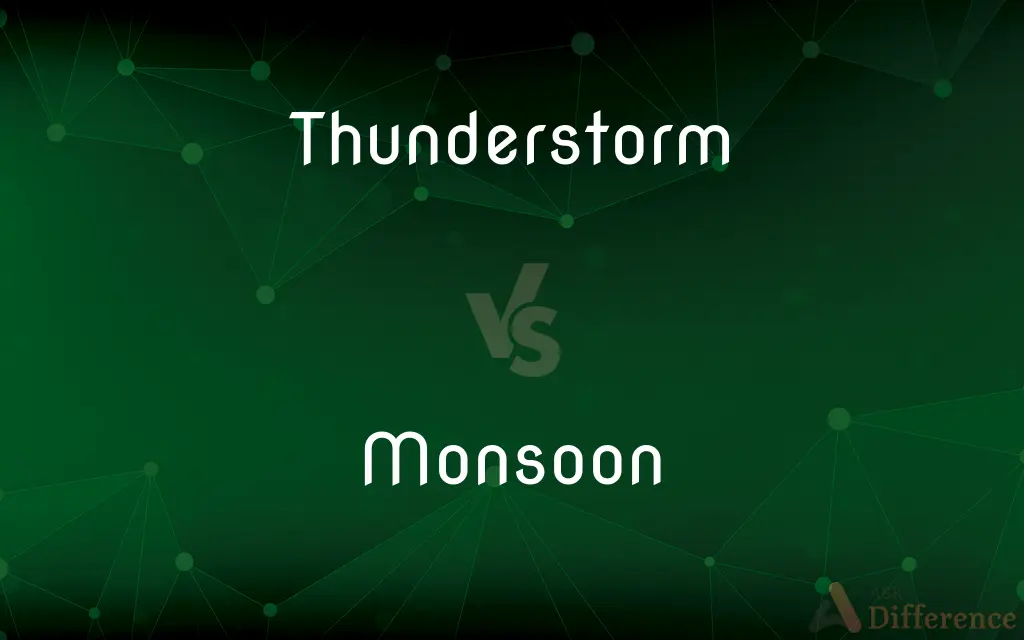Thunderstorm vs. Monsoon — What's the Difference?
By Urooj Arif & Fiza Rafique — Updated on April 9, 2024
Thunderstorms are short-lived, intense weather events characterized by thunder, lightning, and rain, while monsoons are seasonal wind patterns that bring extended periods of precipitation to large areas.

Difference Between Thunderstorm and Monsoon
Table of Contents
ADVERTISEMENT
Key Differences
Thunderstorms are atmospheric disturbances involving thunder, lightning, and often heavy rain or hail, resulting from the rapid upward movement of warm, moist air. They can occur individually or as part of a larger system and are relatively short in duration, usually lasting no more than a few hours. Monsoons, on the other hand, are not single weather events but seasonal wind shifts that cause dramatic changes in precipitation patterns, affecting large geographic regions for months.
While thunderstorms can occur in various climates and locations around the world and at any time of the year, monsoons are specific to certain regions, such as South Asia, Africa, and North America's Southwest. Monsoons are characterized by a distinct wet season, bringing sustained and often heavy rainfall, which is critical for water supply and agriculture in these areas.
The formation of thunderstorms is typically driven by localized atmospheric conditions, such as temperature gradients, humidity, and terrain. Monsoons, however, are the result of larger climatic shifts, particularly the differential heating of land and sea, which affects atmospheric pressure and results in the reversal of wind patterns. This process is predictable and occurs annually.
Thunderstorms can bring about rapid and severe weather changes, including gusty winds, heavy rain, lightning, and sometimes tornadoes, posing immediate risks to life and property. Monsoons, while essential for the replenishment of freshwater resources and supporting agriculture, can also cause widespread flooding and landslides, particularly in regions where the infrastructure may not be prepared for intense and prolonged rainfall.
Despite their differences, both thunderstorms and monsoons play significant roles in their respective ecosystems and human societies. Thunderstorms can provide beneficial rain to dry areas and help reduce air pollution, whereas monsoons are crucial for the economies of large parts of the world, influencing agriculture, water resources, and even culture and traditions.
ADVERTISEMENT
Comparison Chart
Definition
A short, intense weather event with thunder and lightning.
A seasonal wind pattern bringing extended periods of rainfall.
Duration
Hours.
Months.
Geographic Focus
Global, in various climates.
Specific regions (e.g., South Asia, Africa).
Causes
Warm, moist air rising quickly.
Differential heating of land and sea, changing wind patterns.
Effects
Lightning, heavy rain, sometimes hail or tornadoes.
Sustained heavy rainfall, critical for agriculture and water.
Compare with Definitions
Thunderstorm
Can occur singularly or in clusters.
The radar showed a cluster of thunderstorms moving towards the coast.
Monsoon
Is predictable and occurs annually in certain regions.
The monsoon season is a crucial part of the year for the region's water supply.
Thunderstorm
Provides significant precipitation over a short period.
The garden was drenched after last night's intense thunderstorm.
Monsoon
A seasonal reversing wind accompanied by corresponding changes in precipitation.
The arrival of the monsoon rains marked the end of the dry season.
Thunderstorm
Often results from the rapid upward movement of warm, moist air.
The hot, humid conditions were perfect for thunderstorm development in the afternoon.
Monsoon
Brings extended periods of rainfall crucial for agriculture.
Farmers awaited the monsoon to begin planting their crops.
Thunderstorm
A violent short-lived weather disturbance that is almost always associated with lightning, thunder, dense clouds, heavy rain or hail, and strong gusty winds.
The sudden thunderstorm brought much-needed relief to the parched city.
Monsoon
Influences the culture and economy of affected regions.
The festival is held at the beginning of the monsoon season every year.
Thunderstorm
Can cause flash flooding and lightning damage.
The thunderstorm caused flash flooding in the low-lying areas.
Monsoon
Can cause widespread flooding and landslides.
The heavy monsoon rains caused severe flooding in the city.
Thunderstorm
A thunderstorm, also known as an electrical storm or a lightning storm, is a storm characterized by the presence of lightning and its acoustic effect on the Earth's atmosphere, known as thunder. Relatively weak thunderstorms are sometimes called thundershowers.
Monsoon
A monsoon () is traditionally a seasonal reversing wind accompanied by corresponding changes in precipitation, but is now used to describe seasonal changes in atmospheric circulation and precipitation associated with annual latitudinal oscillation of the Intertropical Convergence Zone between its limits to the north and south of the equator. Usually, the term monsoon is used to refer to the rainy phase of a seasonally changing pattern, although technically there is also a dry phase.
Thunderstorm
A storm with thunder and lightning and typically also heavy rain or hail.
Monsoon
A wind system that influences large climatic regions and reverses direction seasonally.
Thunderstorm
A transient, sometimes violent storm of thunder and lightning, often accompanied by rain and sometimes hail.
Monsoon
A wind from the southwest or south that brings heavy rainfall to southern Asia in the summer.
Thunderstorm
A storm consisting of thunder and lightning produced by a cumulonimbus, usually accompanied with heavy rain, wind, and sometimes hail; and in rarer cases sleet, freezing rain, or snow.
Monsoon
A similar seasonal wind, as in the southwest United States, that brings increased rainfall.
Thunderstorm
A storm accompanied with lightning and thunder.
Monsoon
The rain that comes with any of these winds or wind systems.
Thunderstorm
A storm resulting from strong rising air currents; heavy rain or hail along with thunder and lightning
Monsoon
Any of a number of winds associated with regions where most rain falls during a particular season.
Monsoon
Tropical rainy season when the rain lasts for several months with few interruptions.
Monsoon
The rains themselves.
Monsoon
Entire meteorological systems with such characteristics.
Monsoon
A wind blowing part of the year from one direction, alternating with a wind from the opposite direction; - a term applied particularly to periodical winds of the Indian Ocean, which blow from the southwest from the latter part of May to the middle of September, and from the northeast from about the middle of October to the middle of December.
Monsoon
A heavy rainfall in India associated with the southwest monsoon{1}.
Monsoon
The season in which the monsoon{2} occurs.
Monsoon
A seasonal wind in southern Asia; blows from the southwest (bringing rain) in summer and from the northeast in winter
Monsoon
Rainy season in southern Asia when the southwestern monsoon blows, bringing heavy rains
Monsoon
Any wind that changes direction with the seasons
Common Curiosities
What causes a thunderstorm?
Thunderstorms are caused by the rapid upward movement of warm, moist air, leading to condensation and precipitation.
What regions are affected by monsoons?
Regions such as South Asia, Southeast Asia, parts of Africa, and the American Southwest experience monsoon seasons.
How do thunderstorms form?
They form when warm, moist air rises quickly into the cooler atmosphere, causing condensation and precipitation.
Why are monsoons important?
Monsoons are crucial for the water supply and agriculture of large regions, significantly influencing the economy and lifestyle.
Are monsoons predictable?
Yes, monsoons are predictable seasonal phenomena, occurring annually due to climatic shifts.
How do monsoons start?
They start due to the differential heating of land and sea, altering atmospheric pressure and wind patterns.
What are the effects of thunderstorms?
Thunderstorms can cause heavy rain, lightning, hail, and sometimes tornadoes, leading to various impacts like flash flooding and property damage.
What is a monsoon?
A monsoon is a seasonal wind pattern that causes dramatic changes in weather, particularly bringing extended periods of rainfall to an area.
Can thunderstorms occur during a monsoon?
Yes, thunderstorms can occur as part of the monsoon season, especially during the onset of the wet phase.
How do monsoons affect people's lives?
Monsoons can replenish water sources and are essential for farming, but they can also cause floods and landslides, affecting lives and property.
What role do thunderstorms play in the ecosystem?
They provide water, reduce pollution, and can contribute to the nitrogen cycle.
Can monsoons be harmful?
While beneficial for agriculture, monsoons can cause destructive flooding and landslides.
How long do thunderstorms last?
Typically, a few hours, though they can persist longer in a severe weather system.
What's the difference between a monsoon and regular rain?
Monsoon rain is part of a predictable, seasonal wind pattern bringing extended rainfall, unlike sporadic rain events.
What precautions should be taken during a thunderstorm?
Stay indoors, avoid electrical appliances and water, and seek shelter if outside to minimize risk from lightning and flooding.
Share Your Discovery

Previous Comparison
Ipsilateral vs. Unilateral
Next Comparison
Wanker vs. YankerAuthor Spotlight
Written by
Urooj ArifUrooj is a skilled content writer at Ask Difference, known for her exceptional ability to simplify complex topics into engaging and informative content. With a passion for research and a flair for clear, concise writing, she consistently delivers articles that resonate with our diverse audience.
Co-written by
Fiza RafiqueFiza Rafique is a skilled content writer at AskDifference.com, where she meticulously refines and enhances written pieces. Drawing from her vast editorial expertise, Fiza ensures clarity, accuracy, and precision in every article. Passionate about language, she continually seeks to elevate the quality of content for readers worldwide.














































